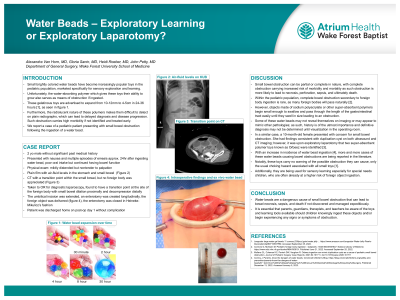Pediatrics
Category: Quickshot Oral Session 14
Quickshot Oral : Quickshot Oral Session 14
WATER BEADS - EXPLORATORY LEARNING OR EXPLORATORY LAPAROTOMY
Sunday, February 12, 2023
7:00am - 8:00am East Coast USA Time


Alexandra Van Horn, MD
Resident
EVMS, United States
Alexandra Van Horn, MD
Resident
EVMS, United States
Presenter(s)
Principal Contact(s)
Objectives: Small brightly colored water beads have become increasingly popular toys in the pediatric population, marketed specifically for sensory exploration and learning. Unfortunately, the water-absorbing polymer which gives these toys their ability to grow also serves as means of obstruction if ingested, as they are advertised to expand from 10-12mm to 4-5cm in 24-36 hours. Such obstruction carries high morbidity if not identified and treated early. We report a case of a pediatric patient presenting with small bowel obstruction following the ingestion of a water bead.
The patient is a two-year-old male without significant past medical history who presented with nausea and multiple episodes of emesis following suspected ingestion of a water bead. Per family, he initially developed poor oral intake but continued having bowel function. On physical exam, the patient was mildly distended but nontender to palpation. Workup consisted of a plain film demonstrating air-fluid levels in the stomach and small bowel and a CT which revealed a transition point within the small bowel, but no foreign body was appreciated. The patient underwent diagnostic laparoscopy, in which he was found to have a transition point at the site of the foreign body with small bowel dilation proximally and decompression distally. The umbilical incision was extended, an enterotomy was created longitudinally, the foreign object was delivered, and the enterotomy was closed in Heineke-Mikulicz’s fashion. The procedure was completed without complication, and the patient was discharged home on postoperative day one without significant event.
Small bowel obstruction can be partial or complete in nature, with complete obstruction carrying increased risk of morbidity and mortality as such obstruction is more likely to lead to necrosis, perforation, sepsis, and ultimately death. Within the pediatric population, complete bowel obstruction secondary to foreign body ingestion is rare, as many foreign bodies will pass naturally. However, objects made of sodium polyacrylate or other super-absorbent polymers begin small enough to swallow and pass through the length of the gastrointestinal tract easily until they swell in size leading to an obstruction. Some of these objects may not reveal themselves on imaging or may appear to mimic other pathologies; as such, history is of the utmost importance and definitive diagnosis may not be determined until visualization in the operating room. Notably, these toys carry no warning of the possible obstruction they can cause, only the usual choking hazard boasted by all small toys.
Methods:
Results:
Conclusion:
The patient is a two-year-old male without significant past medical history who presented with nausea and multiple episodes of emesis following suspected ingestion of a water bead. Per family, he initially developed poor oral intake but continued having bowel function. On physical exam, the patient was mildly distended but nontender to palpation. Workup consisted of a plain film demonstrating air-fluid levels in the stomach and small bowel and a CT which revealed a transition point within the small bowel, but no foreign body was appreciated. The patient underwent diagnostic laparoscopy, in which he was found to have a transition point at the site of the foreign body with small bowel dilation proximally and decompression distally. The umbilical incision was extended, an enterotomy was created longitudinally, the foreign object was delivered, and the enterotomy was closed in Heineke-Mikulicz’s fashion. The procedure was completed without complication, and the patient was discharged home on postoperative day one without significant event.
Small bowel obstruction can be partial or complete in nature, with complete obstruction carrying increased risk of morbidity and mortality as such obstruction is more likely to lead to necrosis, perforation, sepsis, and ultimately death. Within the pediatric population, complete bowel obstruction secondary to foreign body ingestion is rare, as many foreign bodies will pass naturally. However, objects made of sodium polyacrylate or other super-absorbent polymers begin small enough to swallow and pass through the length of the gastrointestinal tract easily until they swell in size leading to an obstruction. Some of these objects may not reveal themselves on imaging or may appear to mimic other pathologies; as such, history is of the utmost importance and definitive diagnosis may not be determined until visualization in the operating room. Notably, these toys carry no warning of the possible obstruction they can cause, only the usual choking hazard boasted by all small toys.
Methods:
Results:
Conclusion:

